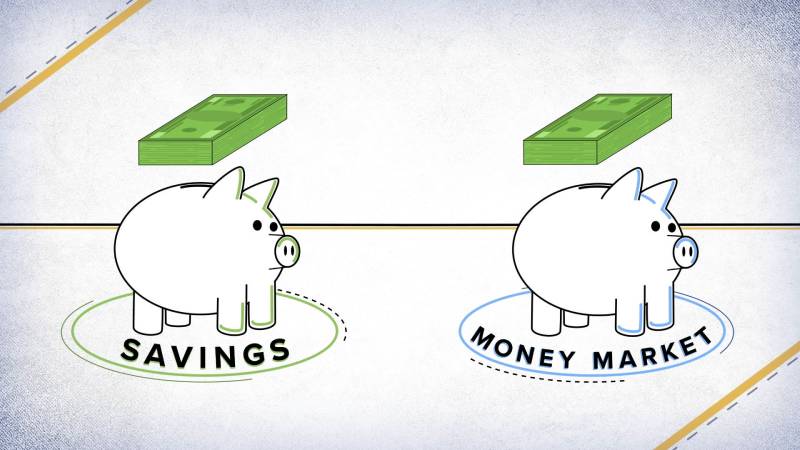Consumers may be unsure about which option to go with when it comes to earning a respectable interest on their assets: money market funds or high-yield savings accounts?
Both serve the same goal. According to Kamila Elliott, a certified financial planner and the CEO of Collective Wealth Partners, based in Atlanta, they typically act as storage facilities for emergency cash or monies set aside for short-term goals, such as the purchase of a car, home, or vacation.
This is due to the stability and availability of money market funds and high-yield savings accounts, two features that are crucial for saving money that you can’t afford to lose and could need in a pinch, according to report.
Greg McBride, chief financial analyst at Bankrate, said, “They’re both very, very safe and give liquidity.
Additionally, they frequently offer rates that are higher than a conventional bank savings account. Over the past 15 months, they have increased significantly as a result of the Federal Reserve raising its benchmark interest rate to control inflation. After spending years close to the basement, several are now earning yields between 4% and 5%.
As of August 28, according to Bankrate, traditional savings accounts yield a pitiful 0.54% on average.
Additionally, customers are not required to make an either-or decision.
Here are some a significant difference.
1. Risk
Bank accounts known as high-yield savings accounts are frequently provided by online banks.
This indicates that they are covered by the Federal Deposit Insurance Corp. Bank deposits are covered by this government-backed insurance up to $250,000 per account.
While still generally safe, money market funds are a little riskier, according to experts.
Brokers and asset managers provide mutual fund investments. The funds typically invest in secure, short-term securities, such as high-grade corporate debt or U.S. Treasury bonds, depending on the fund.
The funds want to keep the share price at $1 a constant. Only a few occasions in history have money funds “broken the buck”—perhaps most memorably in 2008, when the Lehman Brothers bankruptcy caused the share price of the Reserve Primary Fund to drop to 97 cents.
According to a 2012 assessment by the Federal Reserve Bank of Boston, without a capital injection from the funds’ sponsors, at least 21 other funds would have failed between 2007 and 2011.
Money funds do not have FDIC insurance because they are not bank accounts. They are protected by SIPC, or the Securities Investor Protection Corp., which covers the loss of cash and securities up to $500,000 in the event that an investor’s brokerage fails. SIPC protects customer assets during the liquidation process but does not restore value if there was a drop in value, hence it does not safeguard against investment loss.
Government money market funds are a little less risky choice for investors who favour money market funds, according to Elliott. Instead of corporate debt, these invest mostly in Treasurys, the debt of the United States government.
2. Yield
According to Elliott, money market funds typically offer a little higher interest rate than high-yield savings accounts.
According to Crane Data, the highest-yielding money funds currently offer 5.4% to 5.5%. (This yield is expressed as a fund’s average annualised return over the previous seven days. Investment fees, which lower yield, are not included.)
According to McBride, high-yield savings accounts presently pay up to 5.25%.
While they both frequently follow changes in the Federal Reserve’s benchmark interest rate, the causes of their yield increases are different. The Fed directly affects the underlying investments in money market funds, but banks frequently increase dividends to draw in additional customer deposits, which they then lend out to generate money, according to analysts. More deposits are typically attracted by higher rates.
However, McBride noted that current rates are merely a “snippet in time.” High-yield accounts “were measurably above what money funds were paying” from 2008 to 2021, he claimed.
How long the rates will remain this high is unknown. Some experts believe that the Fed will begin lowering interest rates in 2019.
3. Account requirements
According to McBride, minimum deposit requirements for high-yield savings accounts are either absent or minimal.
Money fund minimum investments typically exceed $1,000, according to him.
“That’s not necessarily a hurdle everyone can clear,” McBride said. Consumers would want to be careful about allowing their balance to go below a certain level and incurring a fee, he added.
4. Taxes
According to experts, interest income from both high-yield savings accounts and money funds is taxed as normal income. The federal level of these rates goes as high as 37%.
However, according to Eric Bronnenkant, head of tax at Betterment, some money market funds might offer tax benefits. He emphasised the significance of consumers taking their net yield following taxes into account.
According to Bronnenkant, certain interest income from money funds that hold U.S. Treasury bonds may qualify for a decrease in state and local taxes, but not federal ones.
States typically allow investors to prorate the amount of income tied to U.S. government debt, according to him. For instance, 25% of an investment in a money fund that holds 75% commercial debt and 25% Treasury bonds would be exempt from state and local taxes.
Separately, asset managers also provide municipal money market funds, which invest in tax-exempt municipal assets but typically have a lower yield, according to report.
- Top 5 Health Insurance Stocks to Add to Your Portfolio - July 26, 2024
- 7 Reasons Edamame is Great for Your Health - July 26, 2024
- 2024 Paris Olympics: How Many US Athletes Are Competing? - July 26, 2024





